Every year, over 20 million people get on a cruise ship and set sail for a seafaring vacation. Most of those cruises take their vacationers to warm, sunny climates. But thanks to climate change, a new hoard of ships might start sailing North rather than South. This episode of Flash Forward explores a future where the Arctic becomes a tourist destination just like the Bahamas or the Great Barrier Reef.
Researchers at UCLA have projected that the Northwest Passage might be totally ice-free by 2050. And that’s something that big commercial cargo ships have been eyeing for a while. But now, cruise ships are getting in on the game. The first big cruise ship to make the full Northwest Passage trip was the Crystal Serenity. Here’s the route the ship took.
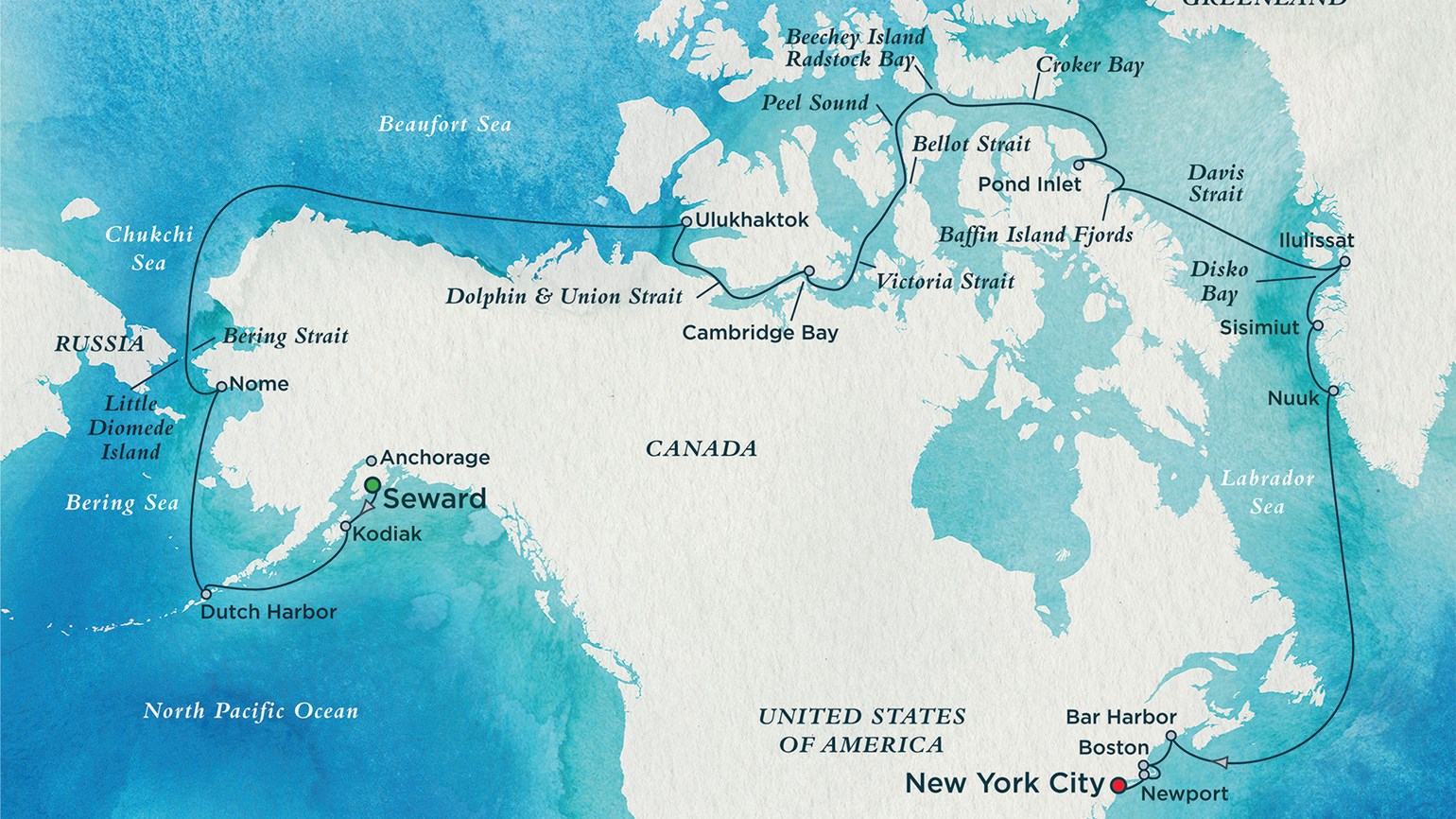
And here’s a promotional video for the cruise:
This week we talk to a few people who have seen the impacts of this new tourism boom.
Arielle Duhaime-Ross is a climate and environment correspondent for HBO’s VICE News Tonight. Arielle went up to Pond Inlet to see the Crystal Serenity, and talk to the people in Pond Inlet about what it’s like to suddenly be flooded with visitors in puffy coats. Here’s her segment.
Jackie Dawson is the Canada Research Chair in Environment, Society and Policy at the University of Ottawa. She’s done a lot of work studying the ways tourism impacts people and the environment in places like Pond Inlet. And she spent years trying to convince people to take arctic tourism seriously.
Nancy Guyon is the Director of Tourism and Cultural Industries for Nunavut, the northernmost Canadian territory. And Nancy’s job is to try and figure out how to harness this new interest in the arctic for the good of Nunavut.
So this future is a little bit unlike some of the other ones I do on this show, because it’s a future that’s kind of inevitable. It’s happening, it’s going to happen. Are communities ready for it? No, is the general consensus. And in this episode we talk about what might happen as this gets more and more popular. What happens when a ship hits and iceberg? What happens when private yachts show up to communities that don’t want them? How do you make sure that these ships don’t disrupt local hunts, and that the tourists respect the people living in these communities?
Flash Forward is produced by me, Rose Eveleth, and is part of the Boing Boing podcast family. The intro music is by Asura and the outtro music is by Hussalonia. The episode art is by Matt Lubchansky.
If you want to suggest a future we should take on, send us a note on Twitter, Facebook or by email at info@flashforwardpod.com. We love hearing your ideas! And if you think you’ve spotted one of the little references I’ve hidden in the episode, email us there too. If you’re right, I’ll send you something cool.
And if you want to support the show, there are a few ways you can do that too! We have a Patreon page, where you can donate to the show. But if that’s not in the cards for you, you can head to iTunes and leave us a nice review or just tell your friends about us. Those things really do help.
The music in this episode was:
Sounds in this episode: “Wind, Synthesized, A.wav” by InspectorJ of Freesound.org
▹▹▹▹▹▹▹▹▹▹▹▹▹▹▹▹▹▹▹▹▹▹▹▹▹▹▹▹▹▹▹▹▹▹▹▹▹▹▹▹▹▹▹▹▹▹▹▹▹▹▹▹▹▹▹▹▹▹▹▹▹▹▹▹▹▹
TRANSCRIPT
Rose: Hi! I’m Rose and this is Flash Forward. Flash Forward is a show about the future, every episode we try to really overthink how a specific tomorrow might play out. We always start with a little audio field trip to the future, and then we jump back to today to talk with real experts, not fake future ones, about what that future might really be like.
Okay. Let’s start this future in the year 2020.
[soothing music]
Woman’s advertising voice (soft and fancy sounding): Welcome, to the Crystal Dream, the world’s largest cruise ship to head to the beautiful frozen Arctic. For years, the Arctic was only accessible to burly adventurers willing to suffer the cold and wind. But now, you too can see what those men risked their lives to witness, the incredible beauty of the tip of our planet. Aboard the Crystal Dream, you’ll get the best of both worlds — incredibly luxurious accommodations, the finest dining, opulent suites, spas and more. As the ship sails through the picturesque Northwest Passage, you’ll see polar bears, seals, whales, and exotic local cultures. It’s the adventure of a lifetime, and it could be yours today.
[news message]
News voice: Officials in Nunavut are warning private ships to steer clear of the Northwest Passage today, as a recent ice melt event has pushed a large iceberg into the passage. Four private yachts have already needed rescue, after colliding with the iceberg. So far, there are no injuries.
News voice: Locals clashed with private vacationers today in Pond Inlet, Nunavut. The locals say that private yachts are disrupting their hunting, and that tourists have routinely interrupted sacred rituals to take photographs. The Canadian government has regulations overseeing the number of cruise ships that can pass through the area, but private yachts are still free to come and go as they please in the region. Pond Inlet recently announced that they would allow no private vessels to dock in their community, and when a yacht recently attempted to defy that order they were turned back without enough fuel or food to make it to the next village.
[epic adventure music]
Man’s advertising voice: The Arctic. The last frontier. At the very tip of our planet, where temperatures get down to 50 degrees below zero. A place few could go without a rescue crew and a team of dogs. But now, you can be one of the few to sail to the Arctic and live to tell the tale. Lodestar Adventures can take you there.
//////
Rose: So, this is a future where the Arctic is totally open to tourism. And I said this would happen in the year 2020 because, it’s already happening. Last year, a giant cruise ship called The Crystal Serenity sailed from New York to Anchorage, Alaska. For most of human history, that trip would have meant going south and around the United States, and then back up the western coast of America.. But the Crystal Serenity went the other way around. Billed as the “ultimate expedition for the true explorer,” the 32-day trip took passengers up into Canada and across what’s called the Northwest Passage and through the Bering Sea. I will post a map of the route online, but basically, instead of going south and around, the ship went up and around; through some of the most remote waters in the Arctic. Waters that, until recently, were almost always completely frozen.
Arielle Duhaime-Ross: So, it’s up north. It’s above Canada. It’s basically the passage that connects the Atlantic to the Pacific.
Rose: That’s Arielle Duhaime-Ross, a climate and environment correspondent for HBO’s VICE News Tonight.
Arielle: And for a really really long time it’s been like this route that nobody… that people can go through with boats. But you know the first person who did it was in the early nineteen hundreds. And he, you know, it took him three years to do it because there was so much thick pack ice. So it’s definitely not a place that has been thought of as accessible.
Rose: But thanks to climate change, the Earth is getting warmer, and the passage is melting more and more every year. Slowly but surely, over the past twenty years, ships have started sailing through the Northwest passage. But so far they’ve been pretty small. Now, big cruise ships like the Crystal Serenity, are sizing up the Arctic as one of the last truly remote tourist destinations. And they’re getting ready to start sailing, sending hoards of tourists in big puffy jackets up into a region that traditionally very few people could access.
And Arielle actually went up to a community called Pond Inlet, which is waaaay up north in Nunavut, to report on the Crystal Serenity.
Arielle: Yes. It’s the first very large.. there are seventeen hundred passenger and crew who were on the boat. And so it’s the first large cruise ship to go through there.
Rose: You might have heard about the Crystal Serenity, because a lot of people were really worried that it was going to hit an iceberg and pull a Titanic.
Arielle: I think that on the whole like they had no issues; they were on time the whole time. But if you think about it in terms of if something were to go wrong, it is a dangerous trip because getting medevacs for that kind of a boat with that many people is like not really feasible.
Rose: Because this was really the first ship of it’s kind making this trip, the people behind the Crystal Serenity did a whole lot of planning to try and reduce this risk. The boat was trailed by a support ship, a research vessel called the R.R.S. Ernest Shackleton. The Shackleton had the capability to break ice if it needed to, and had two helicopters on board just in case. The Serenity itself was equipped with ice detection radar, two ice pilots, and a ton of other safety upgrades. And, thankfully, nothing bad happened. They did not hit any icebergs. The ship sailed through the Northwest Passage, the passengers disembarked at several communities, and they made it through without a problem.
But the Crystal Serenity was a big, giant, bedazzled wake up call for a lot of people. It officially ushered in a new era for the Arctic, turning it into a real, bonafide, big time tourist destination.
And some people are really excited about this development. Nancy Guyon is the Director of Tourism and Cultural Industries for Nunavut, the northernmost Canadian territory.
Nancy Guyon: Okay I will make it very simple as I am explaining to my father who lives in Quebec — Nunavut is above Quebec. We are parallel to Greenland, they are our closest neighbors.
Rose: And Nancy’s job is to try and figure out how to harness this new interest in the arctic for the good of Nunavut.
Nancy: It’s a land, it’s a land of possibilities. I will not say a blank page because there’s some stuff happening, but it’s ready to do, and people are ready to get in the tourism industry. But not at any price, though. But that’s very interesting for me.
Rose: In the last 10 years, tourism in Nunavut has gone from mostly adventure based: dog sledding, hunting trips, survival stuff, to more of the cush, relaxing vacations that appeal to a lot more people. In the past, Nunavut has seen small pleasure cruises, boats that carry maybe 100, 200 people. But now, they’re seeing these much bigger, fancier boats that can bring over a thousand passengers up into the region. And they expect to continue to see those big boats.
Nancy: Actually there are trends that indicate that the cruise industry in Nunavut will continue to experience consistent, predictable growth over the next decade.
Rose: That is basically government speak for yes, there are more cruise ships and there will be more cruise ships. And Nancy’s job is to figure out how to optimize that growth.
Nancy: Always, thinking in the back of our head that it’s well developed, it’s with right regulation, consultation with the communities. It brings jobs to the territory, it brings economic development, it brings another future, a world of possibilities, for new jobs, for having people working in the tourism industry.
Rose: And for some people along the route, this uptick in tourism has already been great.
Arielle: It’s really interesting because we spoke to a lot of the artists there who were trying to sell stuff. Some get a lot of money, like this there’s a guy who lives in Pond Inlet who is a really well known Canadian artist who has sculptures all over Canada. And he he makes a lot of money when people come in.
Rose: But there are also tensions between making the Arctic a great tourist destination and bringing in money for Nunavut, and making sure that tourism is actually good for the local communities involved.
Take Pond Inlet for example — it’s a tiny community, just over 1500 people live there.
Arielle: It’s beautiful. It’s really really beautiful. It’s like 1500 people, largely an intimate community. Like there are white people there but mostly it’s inuit.And it’s a lot of wooden houses, small wooden houses. They have two churches. And it’s federal government housing, because they used to be much more nomadic. So they used to go from place to place And then essentially. maybe in the 1950s, the Canadian government said you’re going to be living here and there’s going to be a town here. So it’s very much a community that is not part of their culture to live the way that they do.
Rose: Pond Inlet is so far north that it’s really hard to grow very much for food.
Arielle: Food is crazy expensive there.. It’s flown in once a week but once a year they get this gigantic cargo ship..
Rose: One of the things that was the most memorable to me about the piece Arielle did for Vice News Tonight about Pond Inlet and this cruise was the shots they had from inside the grocery store. Bell peppers were over five dollars a pound, and a box of frozen chicken strips was $27.
Arielle: When we went there, it’s funny because they had just gotten that cargo ship. So those prices actually shoot up. And it’s actually a lot worse than what we were able to see because they had just gotten that that huge shipment. And then after that things get a lot more expensive, which is why they rely so much on what they call country food, which is just the marine mammals and whatever they can hunt.
Rose: So Pond Inlet is this tiny community, with a really limited food supply.
Plus, just by showing up, these ships might also be disrupting the other major food source for Pond Inlet.
Arielle: Yeah. Well I want to preface that by saying that a lot of this is anecdotal right now. There is a large body of research that says that ships, in general, disrupt marine mammals. That is something that is well studied because it makes it hard for them to communicate. So they can’t necessarily find each other; if they want to reproduce it’s difficult, if they want to find food the marine mammals have trouble. But a lot of the stuff about the Inuit, that they’re saying these ships are scaring the marine mammals, that is what they have found. They have found that certain animals are changing the routes and that they’re out there having to go further out to find these animals. And actually it’s kind of a big problem because if the animals are further out then they’re not migrating the way they’re used to and they might get trapped in the ice in the winter. They’re really worried about the narwhals getting trapped in the ice because they’re not making it out past the Northwest Passage to to do their regular migration route.
Rose: And if the ships don’t scare away those seals and whales the locals rely on, and they do successfully hunt, that can freak out the tourists.
Jackie Dawson: But you can imagine that tourists don’t necessarily want to see a slaughtered seal or a slaughtered whale on the beach when they show up.
Rose: That’s Jackie Dawson, she’s the Canada Research Chair in Environment, Society and Policy at the University of Ottawa. And she has done a lot of work studying the ways tourism impacts people and the environment in places like Pond Inlet.
Jackie: So there is a lot of tension between the cultural tradition of the community and what tourists want to see. They want to see this authentic, what they think is authentic, but really it’s commodified version of touris. And in their tourists minds they don’t want to see a bloody animal on the beach. But really that is the way of life, that is how people live and have for a long time. So there’s lots of tensions.
Rose: So when the Crystal Serenity shows up, with over a thousand people on board, it’s basically doubling the population of Pond Inlet for an afternoon. And if any of those thousand tourists want to use the bathroom in Pond Inlet… it’s actually a huge problem.
Arielle: It’s actually really a problem when there is a large amount of people who come to Pond Inlet in terms of how they treat their sewage. And there’s a huge issue because it’s trucks that come to the houses. There are two hotels in the town and one that has a restaurant; there’s only one restaurant in town. The hotel there refused to let passengers use their bathrooms. They were not allowed, they said no outright. The woman who works in the kitchen there was like, no we cannot handle it; our toilets will overflow; we will have an issue if you have all of these people come here. And then the Crystal Serenity had to try and figure out another spot where passengers would be able to go. So I think they ended up going to the community center and I don’t know how they handled all of that. I have no idea and that’s another thing, that they don’t have the plumbing infrastructure to deal with a bunch of people having to go. They just don’t.
Rose: So there’s the question of food and waste and resources. But there’s also this kind of trickier problem of how to make sure that these tourists are respectful, more generally, and they don’t treat the locals like zoo animals.
Jackie: Tourists were getting off the ships at this time, now this was 10 years ago actually more like 15 years ago now, tourists were getting off the ship and walking around and sticking their faces in the windows of their houses and opening the doors as if they were museum pieces. They’d never seen a northern Inuit community. And so there was a real lack of understanding among the visitors that this was a community. That people lived here, and that you can’t just treat it like a museum. So that was one of their main complaints, back over a decade ago.
I saw a tourist pick up a child and moved the child and placed the child back down again and take a photo so that there was a glacier in the background of the photo. I mean, and that was only five years ago. So there’s still hope there’s still some issues.
Rose: Arielle says she saw the same thing in on her trip.
Arielle: The number of times that I saw, actually not so much for the people on the Crystal Serenity, there were other cruise ships the day before that were there. But the number of times that I saw passengers on cruise ships taking pictures of kids without parents permission? Or like, playing with the kids like it it felt so… icky. It was… it was… it felt so icky.
Rose: And this is all happening now, when only a few ships come through each year. Nancy and her team are aware of these issues too – they’re trying to figure out how to make sure that tourists and locals are both benefitting from these trips. She says she’s not worried about the negatives of these trips, but she does think about how to make them win-win situations for everybody.
Nancy: I would not say worry, because, just because if I worry I will not develop, I will not have this unique job to develop. I think it’s more a question of risk management.
Rose: But what happens in the future, when cruise ship traffic really explodes in the arctic? When it’s not just one or two big ships like the Crystal Serenity, but hundreds? When we come back, we’ll talk about what that future looks like. But first, a word from our sponsors!
[[AD]]
Rose: So now let’s go into the future, when cruises to the Arctic really start to expand. And that won’t just happen in Canada. The ice all around the northern parts of our globe is melting.
Jackie: Each arctic region is quite different, but in Canada before we only had the odd ship before 2005. So one some years there was a ship some years there wasn’t, and around 2005 we had about six ships. Then 2006 came around and all of a sudden we had around 18 or 20 ships coming. And nowadays we have… And when I say ships I mean voyages, sometimes it’s the same ship doing two cruises in the same season. Nowadays it goes up and down but we fluctuate around 22 to 27 voyages in the Canadian Arctic. But that is very different in Greenland in Svalbard where they’re talking about you know 90, 80 or 90 voyages.
Rose: So this future is a little bit unlike some of the other ones I do on this show, because it’s a future that’s kind of inevitable. It’s happening, it’s going to happen. This isn’t space pirates dragging a second moon to Earth.
But it wasn’t always a given that this was our future, it wasn’t always obvious that tourism would push this far north. In fact, just a couple of years ago, Jackie says she didn’t think it would happen.
Jackie: You know what five years ago I would have said absolutely not. There’s so many barriers. For example there’s just not that many ice strengthened ships that you can charter for tourism. People aren’t going to spend the money to build ships just for tourism vessels. But that is, has all changed and people are starting to build tourism specific vessels. They used to just retrofit vessels. So I do think we’re heading in that direction. I don’t think that Canada can handle the number of ships that are in Greenland and Svalbard, but that doesn’t mean they’re not going to come.
Rose: So what changed? What are people suddenly flocking North now? Jackie says it’s a couple of different things. The first is pretty obvious: climate change! Thanks to climate change, researchers at UCLA have projected that the Northwest Passage might be totally ice-free by 2050. Which is really soon. And that’s something that big commercial cargo ships have been eyeing for a while, and it makes sense for cargo ships right? If you can find a more direct route to where you’re going you can save money so you can make money. But when it comes to sending tourists up there, there are other things driving the boom too.
Jackie: People are egocentric individuals and they want to go to the last frontier. They want to be, you know, people want to bag first and the lasts. You know the first to climb Everest the first to you know go to the North Pole or whatever. But nowadays people want to be the last to see a glacier before it melts. They want to be the last to see the polar bears before they’re extinct. You know so they’re being told by the media that they’ll go extinct. So there is this weird little niche market that we’re calling “last chance tourists” and that we’ve seen a major increase in demand that is directly related to people just wanting to go see the arctic before it’s going to be changed forever. And of course climate change is what’s driving this idea that it’s going to be changed forever.
Rose: But some of the things that make the arctic so appealing, are also things that might go away if it’s suddenly inundated with cruise ships.
Guyon: It’s personal. I think it will be on the, wishlist of more and more people to be able to see the arctic, to see wildlife, to experience the unique landscape, the uniqueness of this pristine environment. The quietness also that we don’t have much anymore in our cities and our neighborhoods, so here it’s very very very different.
Rose: Pristine environments, quietness, those are two things I don’t necessarily equate with a lot of cruises.
Now, there is some dark humor in this cruise, right? I mean, climate change is disproportionately caused by wealthy people, the exact wealthy people who are able to spend tens of thousands of dollars on a cruise through the passageway that is now open, thanks to climate change that they helped to cause. And this wasn’t lost on people. Over at Slate, Will Oremus called the cruise, “a massive, diesel-burning, waste-dumping, ice-destroying, golf-ball-smacking middle finger to what remains of the planet, courtesy of precisely 1,089 of its richest and most destructive inhabitants.” And Jackie says that at first, she was actually inclined to agree with him.
Jackie: I know the ironey eh? The irony it’s kind of hilarious. When I first started thinking of this I was, you know took that stance, of this is this is a horrible thing! Because of course going to the Arctic you’re releasing greenhouse gas emissions and creating you know contributing to the problem.
Rose: But she says that she’s softened her view a bit after taking a closer look at the cruises.
Jackie: But most of these people are extremely educated, motivated, and they in tern become ambassadors for the region. So what we need really great companies like there’s a Canadian company called Adventure Canada and they offer different programs where you can offset your carbon emissions and you know donate to different organizations like Polar Bears International et cetera. So these people going they have money, usually, because it’s not cheap to go. So I don’t know if they all fully comprehend the connection but they’re definitely, typically, engaged in educated citizens.
Rose: And Nancy and her team have been working on best practices, guides for ships and their passengers. Many of them employ guides to prepare visitors and make sure they’re culturally conscious in their interactions. Many of those guides are Inuit people themselves. A number of the smaller cruises bring scientists along, to give lectures about climate change and the science behind why these ships can even sail through these waters in the first place. How many people onboard actually go to those lectures, I don’t know, but it’s a start?
So what happens next? What does 2020 look like?
Jackie: So in the short term there is likely to be this rapid increase and there has been I mean this is what we kind of expected. Because people are excited, it’s new, it’s opened the Northwest Passage you can generally get through pretty much every year now and that’s where people want to go. It’s very exciting place. But there will be potentially at some point a tipping point where there’s too many vessels the region can’t support it and we’ll see some sort of crash. I mean this is a very basic business cycle, where you see development, rapid development, and then there’s sort of a threshold at which you can’t really handle this amount of development and then and then we could see some sort of crash.
And when I say crash what I mean is I think it’s highly likely that we will at some point see some sort of catastrophic situation. You know we almost had a ship sink in 2011 the only reason it didn’t sink was because it got stuck on an underwater flat cliff. But in the Antarctic they had a vessel you know the Explorer hit iceberg and sunk in the Antarctic. They got everyone off. But I mean I think it’s a matter of time before we see some sort of major disaster be it environmental or human or something. So there is a tipping point somewhere.
Rose: So there will almost certainly be more ships. And one of the big concerns people have is that future ships might not do all the planning that the Crystal Serenity did. That trip took years and years to plan, and they made sure to have every possible safety backup they could think of. And that’s in part because they were the first and there were so many eyeballs on them. But as these trips get more normal, and as companies try to cut corners and make more money by spending less, we will probably see a dip in safety procedures.
Jackie: The crystal Serenity they did a really good job planning these 10 years planning, but the next ship, there’s no real requirement for that. So then the worry is the next ship that comes in that doesn’t plan as well as the Crystal Serenity really did. And yes absolutely people are worried about that.
I mean search and rescue is a challenge. Canada has six icebreakers five of which are typically operational. They’re all reaching the end of the age their age of operation. We have plans to maybe build another one that keep getting delayed. And the Canadian Arctic is enormous. We just, we do not have the kind of search and rescue services that would be needed. Should we have the towed the number of cruise ships that other Arctic nations have. We just were not there. So we’re going to be playing catch up.
Rose: And beyond safety concerns, a lot of people are worried about what a sudden influx of tourists might do to local communities. No matter how much good planning Nancy and her team does, there’s no way that everybody is going to be happy. Just like in the United States, the Canadian government’s relationship with First Nations people is a rocky one. There isn’t a whole lot of trust there, and for good reason.
Jackie: Just to back up one second along these lines I think what’s really interesting about this is that tourism could be a second colonization of the region. So I don’t know if you know the history of Arctic Canada but, these are forced relocations. So for settlements. So back in the 40s 50s 60s we took, the Canadian government took Inuit groups which were in different places and move them to the Arctic in these particular communities where they are now for reasons of sovereignty. And sort of you know staking claims. So there is a real native history of colonization in the region. And so there is this idea among local residents that tourism could be a second colonization of the region. So it could take over the region in a way that the federal government did in the past.
Rose: This is a classic problem when it comes to tourism — how do you balance keeping people happy and safe and maintaining communities, while also opening up a region and trying to bring in tourist dollars. And of course, locals don’t all agree. Some see the boom in tourists in their big puffy jackets as a great thing, an influx of money into communities that are often scraping by. Others see an intrusion, a colonial force, an influx that does more harm than good.
Jackie: It’s a mixed bag, what local people think some people are pretty excited about it and some people are really not thrilled at all. Some people hide the entire season. If cruise ship comes they’re just hiding. They just go in their house and hide.
Rose: And that works when it’s just one or two ships a year. It doesn’t work when it’s 100. So some communities might just decide they don’t want to participate, they don’t want cruise ships, they’d rather they just sail by and wave from the water. Arielle says that she suspects some local communities will try to turn cruise ships away. But right now the actual rules about how that works are really murky.
Arielle: There are no rules that negotiate how much you need to pay to dock. Like it’s very much a negotiation between the small town and this ship and what are you going to do say no? Like you know these governments like me maybe want these ships to stop by?
Jackie: Yeah so it is technically a local decision. There are communities like Clyde River and I think Arctic Bay might have too, they just said no cruise ships. We’re not allowing cruise ships for the next five years. So that’s possible, so some communities that know that they can do that, do that. But then, the territorial government is trying to start to regulate these sort of things. They’ve put together some official regulations but mostly it’s governed through voluntary guidelines that that aren’t you know sort of legally binding. You can’t. I mean technically you can you can say no cruise ships but a cruise ship could still show up. Obviously they wouldn’t be welcomed very warmly but there’s no law in place that says you cannot stop at this community.
Rose: But at least the government is even thinking about this stuff.
Jackie: Oh yeah. Yeah. Now there are. Oh absolutely. It’s it’s definitely in the public consciousness now. Ten years ago I was fighting. I was fighting all the time! We would talk about shipping in the Arctic and governance and whatever and I would say “and don’t forget about the cruise ships!” Because everyone was talking about resource ships and etc. but nowadays it is definitely on the agenda.
Rose: But Jackie also says that there’s an element of this conversation they’re not talking about, and that worries Jackie way more: private ships. The Canadian government has some control over how many cruise ships come in and out, and how they operate. It’s a complex relationship, one that does have some give and take on both sides, but it exists. With private ships, however, there’s really nothing anybody can do to regulate them.
Jackie: The big cruise ships are one thing but the thing that we haven’t talked about yet are the little yachts. So the private yachts that are that are heading up and that’s the right now that is the fastest growing marine sector in the Canadian Arctic and that sector grew by 400 percent since 2005. So those little boats we need to start paying attention to also. We can’t regulate those little boats they fall they’re under 300 gross tonnes, none of the regulation applies to them. They can go where they want when they want. They probably haven’t you know necessarily looked up all the Web sites about information both you know communities and things. So nowadays, I used to fight, I used to fight to get attention on the issue of cruise ships and now I’m fighting to get attention on those small vessels.
Rose: And on a private ship there are no tour guides, there are no first nations people guiding them, they just kind of show up and do whatever they want I guess? What both Jackie and Arielle worry most about is the toll that visitors might take on traditional communities. Sure, some of these people might be quite well educated and be there for the right reasons. Others… might not.
Arielle: I don’t think that necessarily having like a bunch of tourists come into these towns will make racism go away because then, what they’ll be more contact with Inuit communities? No the Inuit communities will just experience more racism. Like that is a thing that will happen. So yeah that’s another thing that I envision like it that’s that’s another future for them is just like how being confronted with more ignorance. You’re just going to have a community that’s going to get whacked in the face by racism over and over and over again and it’s going to be so painful.
Rose: Some communities might decide that is worth enduring for the money. Which is a pretty awful calculus to have to do.
Arielle: I think that it’ll be a question of, how angry they get and whether they allow themselves to express that anger. And I also think it’ll be a question of like, how much they end up relying on the money that the cruise ships bring in and or give them to dock. You know there’s a lot that people will put up with if they get a little bit of money. Like for you know three days of incredibly painful interactions. Communities of color are very very used to taking, to like living with a lot of like terrible things because they need to make ends meet and they need to feed themselves.
Rose: Right now, the Arctic is at a bit of a critical point. Leaders could figure out a way to preserve the arctic, allow some tourism, and maintain the health and wellbeing of local communities. And I do think they’re trying. But it’s really complicated! ANd nobody can really agree on what the best course of action is. It’s possible our future is one of well regulated arctic tourism where some people can go up and see this and the communities make money and everybody is happy. But it could be that the Arctic tourism boom is really detrimental. And we don’t really know what will happen. We’ll have to wait and see.
That’s all for this future! If you want to learn more about arctic tourism, melting sea ice, and what the future of exploring the northwest passage might be head to flashforwardpod.com where I’ll post links to more resources.
If you are interested in keeping up with news about native communities in the US and Canada, there’s this podcast that I really like called National Native News. It’s a daily podcast, but it’s just five minutes a day, and it’s all dedicated to Native issues. Check it out on your podcasting app!
Flash Forward is produced by me, Rose Eveleth. The intro music is by Asura and the outtro music is by Hussalonia. The music from our future scenes this episode was by BoxCat Games and Oorlab. Special thanks to Jon Olier, Kimberly Shaffer, Bektour Ryskeldiev, Ari Baronofsky and Jennifer G. Cheung. The episode art is by Matt Lubchansky.
If you want to suggest a future we should take on, send us a note on Twitter, Facebook or by email at info@flashforwardpod.com. We love hearing your ideas! And if you think you’ve spotted one of the little references I’ve hidden in the episode, email us there too. If you’re right, I’ll send you something cool.
And if you want to support the show, there are a few ways you can do that too! We have a Patreon page, where you can donate to the show. But if that’s not in the cards for you, you can head to iTunes and leave us a nice review or just tell your friends about us. Those things really do help.
The music in this episode was:
BoxCat Games, “Love of my Life”
Sounds in this episode:
“Wind, Synthesized, A.wav” by InspectorJ of Freesound.org
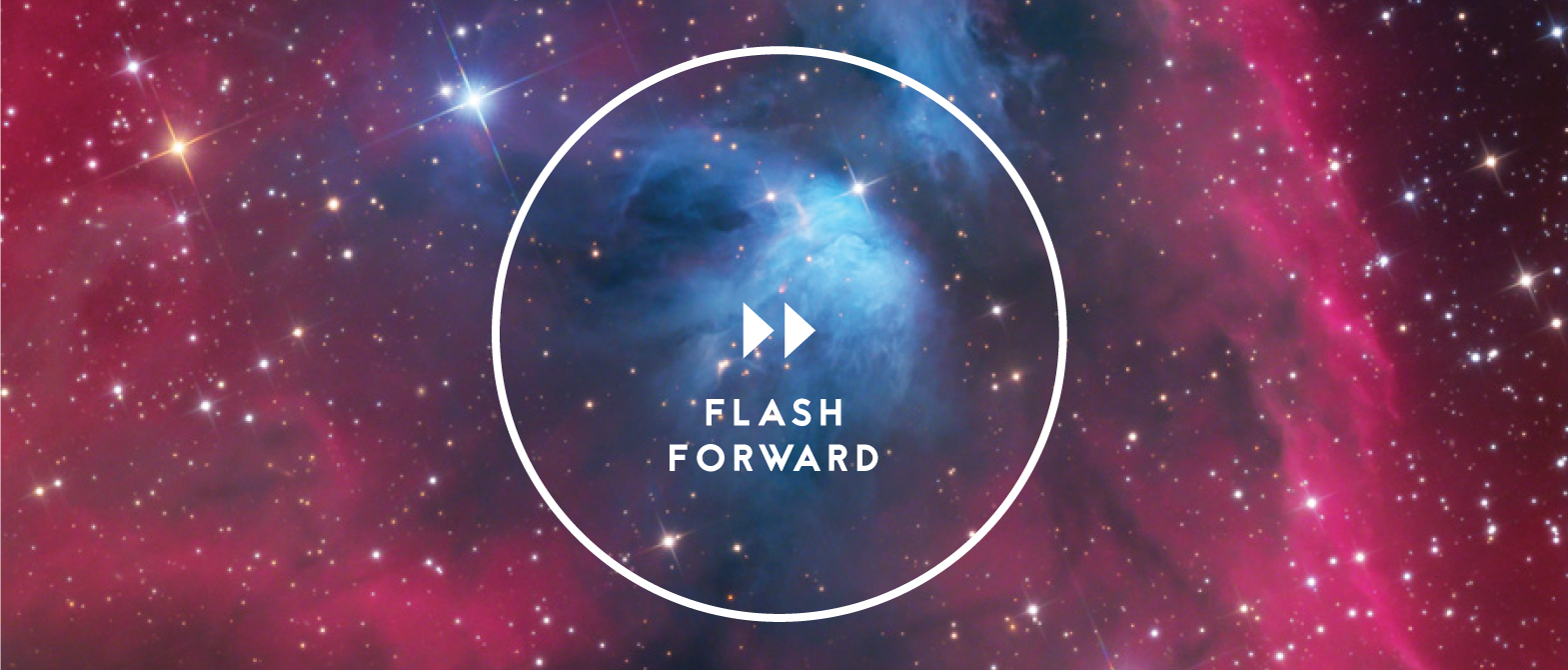
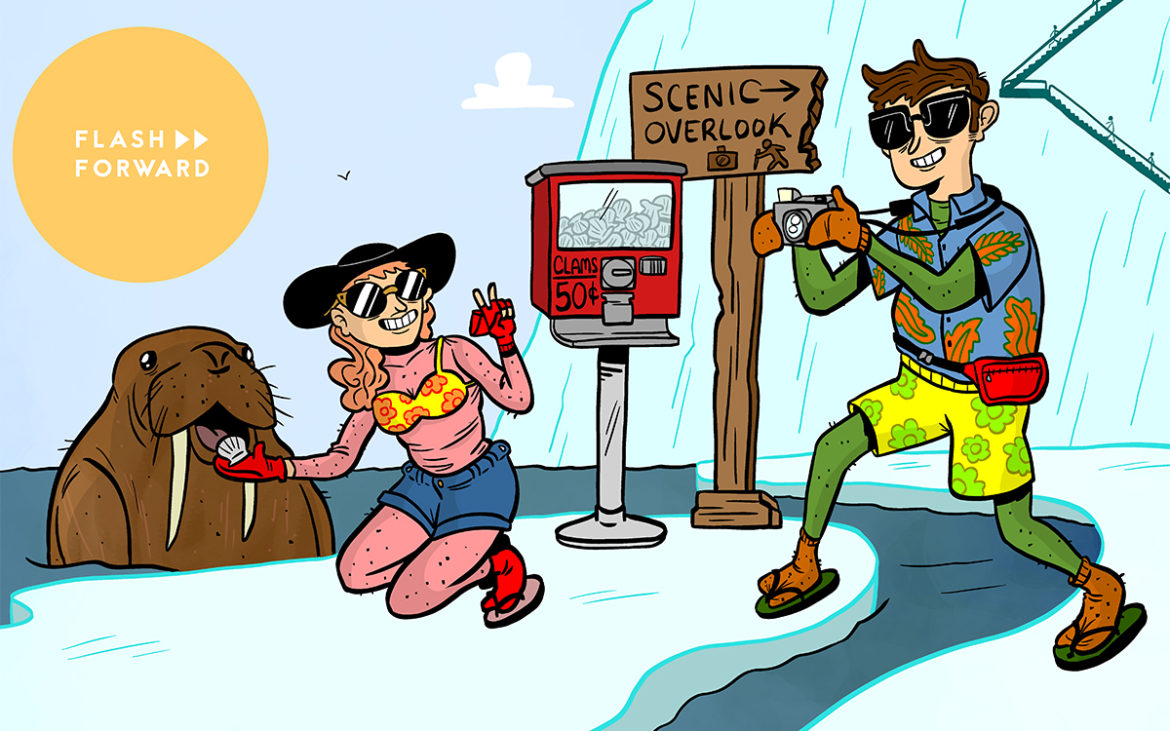
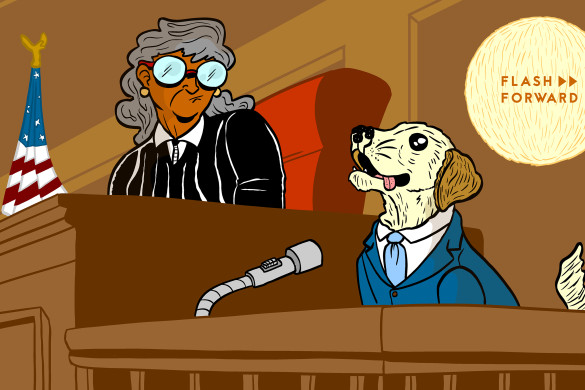
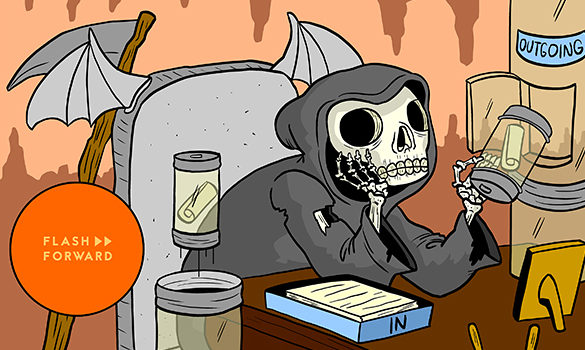


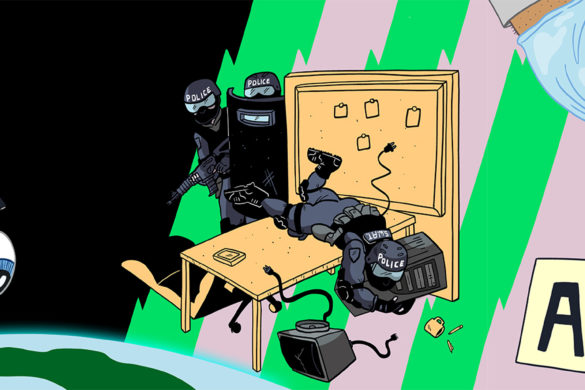
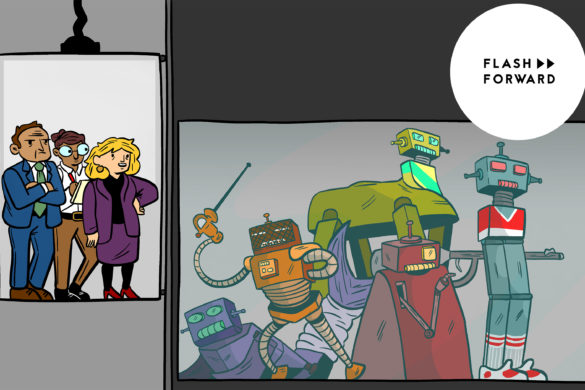

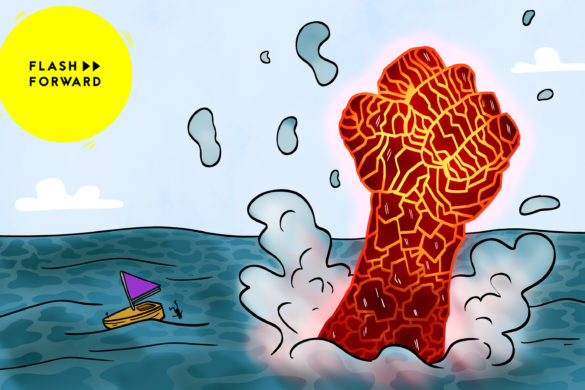
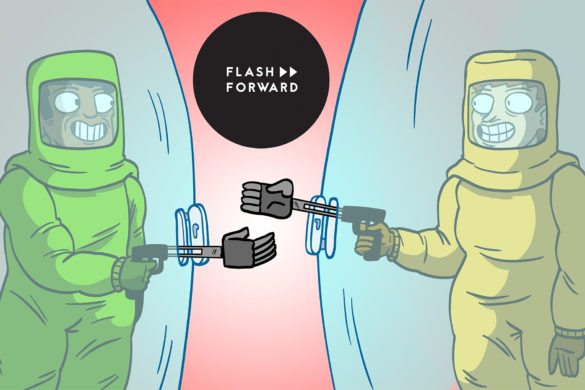

6 comments
This episode was really interesting and informative!
[…] Northwest Passage Tourism 38 mins – “Every year, over 20 million people get on a cruise ship and set sail for a seafaring vacation. Most of those cruises take their vacationers to warm, sunny climates. But thanks to climate change, a new hoard of ships might start sailing North rather than South. This episode of Flash Forward explores a future where the Arctic becomes a tourist destination just like the Bahamas or the Great Barrier Reef.” At the link right-click “Download” and select “Save Link As” from the pop-up menu. […]
Big fan of the pod. I enjoy the sci-fi-esqe futures that you explore in most of your episodes, but I was really taken aback by “Greetings from Paradice.” While the podcast is always thought provoking, I found this episode to be exceptionally powerful.
This subject was incredibly fascinating because it’s a future that is absolutely going to happen in the next few years and will have a huge impact on the people who live in arctic, their resources, their infrastructure and all of the safety and legal concerns that go along with increased boat traffic due to global warming… I would absolutely encourage to you to explore similar near futures in upcoming episodes, because I think current global trends are about to have similar impacts on smaller communities in very real and potentially detrimental ways and your podcast is the perfect forum for that kind of discussion.
This episode was cool, pun intended. LOVE LOVE LOVE
[…] https://www.flashforwardpod.com/2017/02/07/greetings-from-paradice/ […]
[…] uit een toekomst vele eeuwen ver weg tot iets wat binnenkort zou kunnen gebeuren. Denk aan een toekomst waarin Antarctica een toeristische trekpleister is door middel van cruiseschepen of een toekomst […]